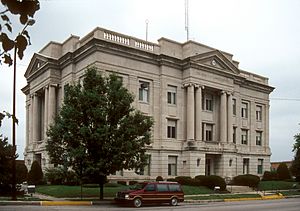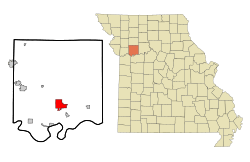Richmond, Missouri facts for kids
Quick facts for kids
Richmond, Missouri
|
|
|---|---|

Ray County Courthouse in Richmond
|
|

Location of Richmond, Missouri
|
|
| Country | United States |
| State | Missouri |
| County | Ray |
| Named for | Richmond, Virginia |
| Area | |
| • Total | 6.17 sq mi (15.98 km2) |
| • Land | 6.15 sq mi (15.93 km2) |
| • Water | 0.02 sq mi (0.05 km2) |
| Elevation | 814 ft (248 m) |
| Population
(2020)
|
|
| • Total | 6,013 |
| • Density | 977.72/sq mi (377.51/km2) |
| Time zone | UTC-6 (Central (CST)) |
| • Summer (DST) | UTC-5 (CDT) |
| ZIP code |
64085
|
| Area code(s) | 816 |
| FIPS code | 29-61670 |
| GNIS feature ID | 2396368 |
| Website | City of Richmond Official Website: http://www.cityofrichmondmo.org |
Richmond is a city in Ray County, Missouri. It is part of the larger Kansas City metropolitan area in the United States. In 2020, about 6,013 people lived here. Richmond is also the main city, or county seat, of Ray County.
Contents
History of Richmond
Richmond was officially planned and laid out in 1828. The city was named after Richmond, Virginia, a well-known city in the state of Virginia. A post office has been open in Richmond since it was founded in 1828.
Geography and Location
Richmond is located in the southern part of Ray County. It sits where two main roads, Missouri Route 10 and Missouri Route 13, meet. The west fork of the Crooked River flows to the northeast of the city.
The city of Lexington is about eight miles southeast of Richmond. Lexington is in Lafayette County and is located on the south bank of the Missouri River.
Land and Water Area
The United States Census Bureau says that Richmond covers a total area of about 5.90 square miles (15.28 square kilometers). Most of this area, about 5.88 square miles (15.23 square kilometers), is land. Only a small part, about 0.02 square miles (0.05 square kilometers), is water.
People of Richmond
| Historical population | |||
|---|---|---|---|
| Census | Pop. | %± | |
| 1860 | 615 | — | |
| 1870 | 1,218 | 98.0% | |
| 1880 | 1,424 | 16.9% | |
| 1890 | 2,895 | 103.3% | |
| 1900 | 3,478 | 20.1% | |
| 1910 | 3,664 | 5.3% | |
| 1920 | 4,409 | 20.3% | |
| 1930 | 4,129 | −6.4% | |
| 1940 | 4,240 | 2.7% | |
| 1950 | 4,299 | 1.4% | |
| 1960 | 4,604 | 7.1% | |
| 1970 | 4,948 | 7.5% | |
| 1980 | 5,499 | 11.1% | |
| 1990 | 5,738 | 4.3% | |
| 2000 | 6,116 | 6.6% | |
| 2010 | 5,797 | −5.2% | |
| 2020 | 6,013 | 3.7% | |
| U.S. Decennial Census | |||
Population in 2010
In 2010, there were 5,797 people living in Richmond. These people lived in 2,430 households, and 1,475 of these were families. The city had about 986 people per square mile (381 people per square kilometer). There were also 2,777 housing units, which are homes or apartments.
Most of the people in Richmond were White (93.7%). About 3.2% were African American, and smaller percentages were Native American, Asian, or Pacific Islander. About 2.1% of the population was Hispanic or Latino.
The average age of people in Richmond was 39.5 years old. About 23.2% of residents were under 18 years old. About 18.2% were 65 years or older. There were slightly more females (53.5%) than males (46.5%) in the city.
Arts and Culture
Richmond has interesting places to visit that show its history and support the arts.
Museums to Explore
The Ray County History Museum is a great place to learn about the area's past. It is home to the Ray County Historical Society and a library for people studying their family history. The museum building was built in 1910. It used to be a "Poor Farm," which was a place where people who needed help could live and work. The building is now listed on the National Register of Historic Places.
Inside the museum, you can find many exhibits. They show artifacts from different time periods, like the Civil War and both World War 1 and World War 2. There are also exhibits about Mormon history and what life was like on old homesteads in the area.
Visual and Performing Arts
The Farris Theatre is a historic building that first opened in 1901. It was designed by famous architects from Kansas City. This theater is also listed on the National Register of Historic Places. Today, a non-profit group called Friends of Farris Theatre runs it. They host live shows and screen digital movies for the community.
The Farris Theatre is part of the Farris Arts District. This area also includes the Hall for Arts Education and the Gallery and Museum for Fine Arts. These art spaces are located in old buildings that were once used by groups like the Order of Knights of Pythias and Fraternal Order of Eagles.
Parks and Recreation
Richmond has about 60 acres of parkland spread across five public parks. These parks offer many ways for people to enjoy the outdoors and stay active.
City Parks
- Southview Park is the largest park, with 35.3 acres. It has a public outdoor swimming pool and a community amphitheater for performances.
- Cevie Due Park is where the city's skate park is located.
- Maurice Roberts Park features a decommissioned Lockheed T-33 jet trainer airplane on display.
- Hamann Park is the newest park and is still being developed. Plans for this six-acre wooded area include a nature walk.
In addition to the parks, the city also has a gymnasium. This gym is now part of the city hall complex. It was originally built in 1955 as the gym for Richmond High School.
Golf Course
Richmond is also home to an 18-hole golf course. This course was designed in 1969 by Chet Mendenhall, a well-known golf course designer.
Education in Richmond
Richmond has a school district that serves its students from elementary to high school.
Schools in the District
The R-XVI School District operates four public schools:
- Dear Elementary School
- Sunrise Elementary School
- Richmond Middle School
- Richmond High School
Libraries for Learning
The Ray County Library was officially created by voters in 1946. It has been at its current location on 215 East Lexington Street since 2004. The library offers a special room for genealogy research, a community room for events, and a computer training lab.
The Ray County Genealogy Association also has its own library. This library is located inside the Ray County Museum.
Notable People from Richmond
Many interesting people have connections to Richmond, Missouri. Here are a few:
- Alexander William Doniphan – A soldier and political figure from the 1800s who spent his later years in Richmond.
- Lenvil Elliott – An NFL player who won a Super Bowl with the San Francisco 49ers.
- Robert Ford – Known for his role in the story of Jesse James.
- Austin Augustus King – Served as the Governor of Missouri from 1848 to 1853.
- Dan Lanning – The head coach for the Oregon Ducks football team.
- Michael Letzig – A professional golfer.
- Charles H. Mansur – A U.S. congressman.
- Jacob L. Milligan – A U.S. congressman.
- Maurice M. Milligan – A U.S. attorney.
- John Rooney – A well-known radio and television sportscaster.
- Forrest Smith – Served as the Governor of Missouri from 1949 to 1953.
- Beryl Wayne Sprinkel – An economist.
- David Whitmer – Served as an early mayor of Richmond.
Images for kids
See also
 In Spanish: Richmond (Misuri) para niños
In Spanish: Richmond (Misuri) para niños





